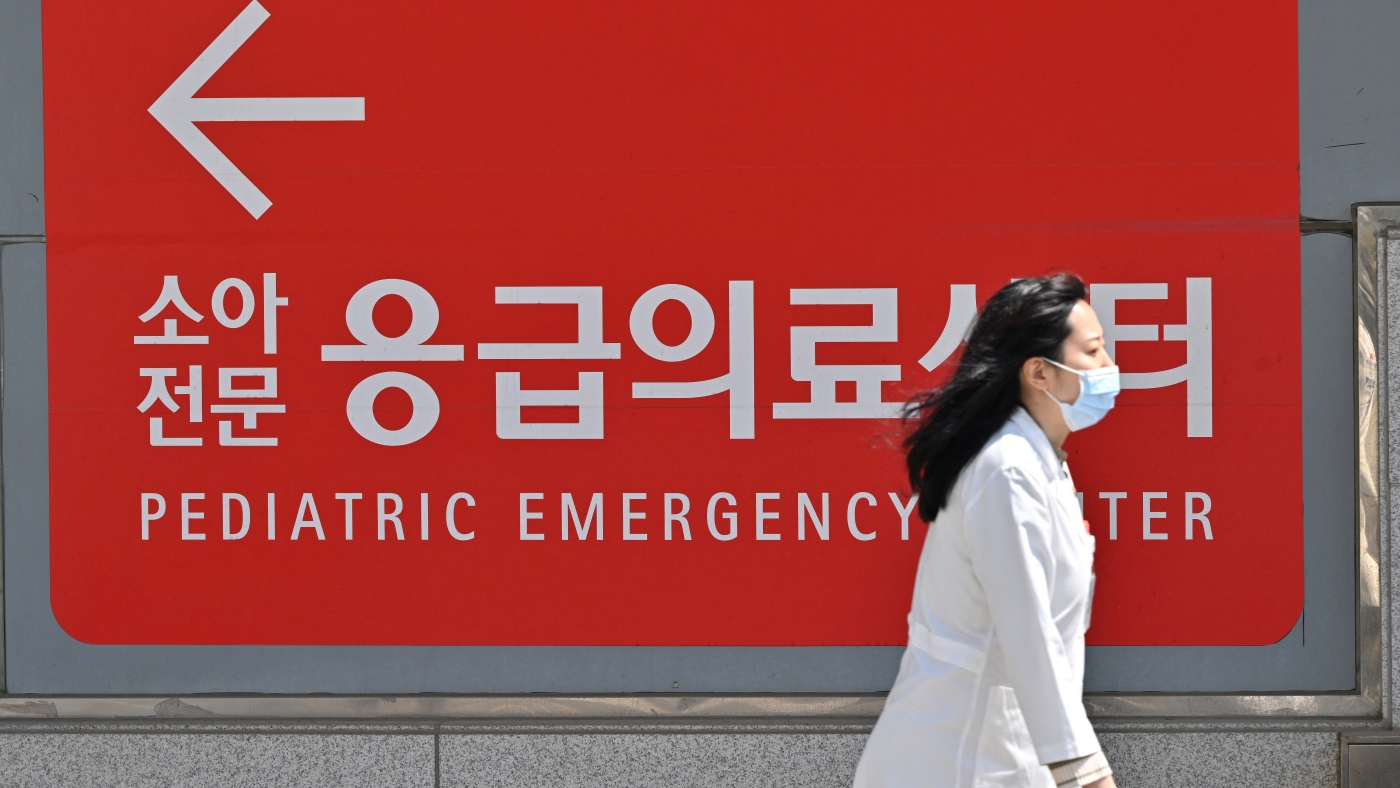A medical worker walks past a sign for a pediatric emergency centre outside a hospital in Seoul on April 1, 2024.
JUNG YEON-JE/AFP via Getty Images
hide caption
toggle caption
JUNG YEON-JE/AFP via Getty Images
SEOUL, South Korea — Shortly after the South Korean President Yoon Suk Yeol announced a plan to increase the number of doctors in February, his approval rate got a bump.
The fast-aging country was already seeing a shortage of doctors in rural and remote regions, and demand for healthcare would grow even more.
So the public was largely on board with the government on the issue, even as more than 10,000 trainee doctors walked off their jobs in protest, saying the government’s proposal wouldn’t solve the problem.
Seven months have passed since, and the doctors haven’t returned. That same plan of adding 2,000 medical students each year is now the biggest reason people disapprove of Yoon’s performance in the weekly Gallup poll. Nearly eight out of 10 people say they are afraid they won’t be able to receive medical care when they get sick. Yoon’s approval rate is the lowest since he took office.
As the standoff between the government and striking doctors continues, there are now signs that South Korea’s healthcare system is buckling under the strain.
Major hospitals are conducting 16% fewer cancer surgeries this year. Emergency responders are struggling to find hospitals that can take patients in, and a handful of emergency clinics nationwide have partially suspended operations.
The government has downplayed the severity of the situation, with President Yoon saying at a recent policy briefing that the medical system is “operating smoothly.” But patients and their families say they feel helpless and anxious not knowing when the crisis will end.
Suh Yiseul scheduled her son’s biopsy just before the strike began. Her 11-year-old Kai wanted to start a new medication to treat his Klippel-Trenaunay Syndrome, a rare blood vessel disorder that causes pain and makes his legs swell and grow asymmetrically. Checking for genetic mutation would be the first step for the treatment.
But the biopsy was delayed from April to May, and then to September, due to staff shortage. And this month, just hours before the appointment, she got a text message from the hospital notifying yet another delay. The hospital said it had no bed left for child patients.
“Even if we do the biopsy now, we won’t get the results before next spring. And my child will continue to hurt in the meantime. He gets cellulitis every time the seasons change. And the difference in the length and thickness of his legs keeps growing,” Suh says.
But no resolution is currently in sight. The government is pushing ahead with its plan to add 2,000 more students to the current quota of around 3,000 in next year’s medical school admission. Doctor groups demand the plan be called off entirely. Neither side is willing to even engage in a dialogue unless the other side gives in.
It will take years for the expanded batch of new graduates to arrive in hospitals and ease the labor shortage. Meanwhile, current medical students are boycotting classes and licensing examinations in solidarity with the trainee doctors, and training hospitals barely received any applicants for their summer recruitment.
The departure of nearly 9 out of 10 training doctors has been so disruptive to the country’s largest general hospitals because they make up around 40% of physicians there.
And, according to the intern and resident doctors, that structure is why they reject the government’s reasoning that having more doctors will increase medical access across regions and medical sectors.
They say that their long work hours and low salary has propped up South Korea’s healthcare system, which they say undercompensates medical care that tends to vital bodily functions —- like internal medicine, emergency care, cardiac surgery, obstetrics, and pediatrics.
Without a reform of that system, they say, hospitals will continue to underinvest in those fields of medicine and rely on trainee doctors’ cheap labor to run them. Working conditions in those fields will keep deteriorating, and doctors, however many there are, will continue to shun them.
Under the highly commercialized healthcare system in South Korea, resources are concentrated in profitable fields like cosmetic surgery and dermatology, says Lee Sang Yoon, a senior fellow at the civic research group Center for Health and Social Change.
He says increasing the number of public hospitals can be a solution. According to data from the country’s health ministry, only about 5% of all medical institutions in South Korea are publicly owned – far lower than the average of over 50% among member states of the Organisation for Economic Co-operation and Development (OECD).
But Lee is skeptical that the doctors would agree to such a fundamental reform when they have so strongly resisted increasing medical school admissions.
He says South Korean doctors are indeed overworked, citing the country’s relatively low number of doctors per capita compared with other OECD countries.
But, South Korean doctors on average enjoy high incomes in return in comparison to other affluent countries. Lee argues doctors’ anxiety over losing that compensation once the supply of doctors increases is part of the reason they are opposing the hike.
And he says the government is papering over the complex tangle of interests and fundamental problems with a “populist” approach of highlighting the issue of doctors’ numbers and labeling doctors as a “cartel.”
Even if the doctors end up prevailing over the government, Lee adds, they will have lost the trust of patients and citizens. “Healthcare is a system based on trust,” he says. “It will likely be a victory in name only.”

